Laboratorio
di Liuteria Antica
Tonewoods
 BUY MAPLE
BUY MAPLE  Violin *** Viola *** Cello *** Guitar
Violin *** Viola *** Cello *** Guitar
 BUY SPRUCE
BUY SPRUCE  Violin *** Viola *** Cello
*** Guitar
Naturally seasoned Spruce from Italian
Alps
Violin *** Viola *** Cello
*** Guitar
Naturally seasoned Spruce from Italian
Alps
for violin, viola, cello, viola
da gamba, guitar & lute
Wood suitable for making musical instrument 's belly
is a special kind of wood. It is possible to obtain from some
sort of quality spruce - picea excelsa (Picea abies
H. Karsten)- which grows at high altitude (1000 till 1400
meters above the sea level). These trees, pyramidal in shape and
evergreen, are extremely long-lived and cold-proof.
|

spruce trees during winter season and...
|

...mountain view during summer
|
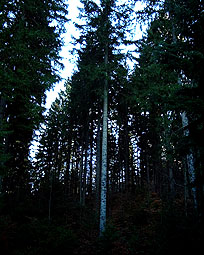
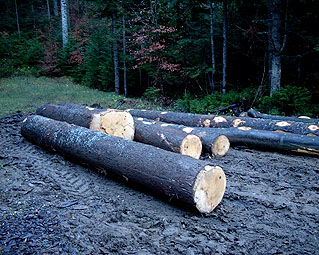 Among these special trees, well known and appreciated
from old Italian violin masters in the last past centuries, the
only one used for instrument making is hazel spruce. Because
in English speaking countries this kind of tree does not grow
is the name only a translation from German haselfichte
, Italian abete rosso (maschio) and Slovene smreka (mandelc).
Among these special trees, well known and appreciated
from old Italian violin masters in the last past centuries, the
only one used for instrument making is hazel spruce. Because
in English speaking countries this kind of tree does not grow
is the name only a translation from German haselfichte
, Italian abete rosso (maschio) and Slovene smreka (mandelc).
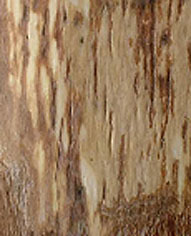 This tree has some specific tonewood characteristic
and distinguish from others for some small longitudinal few centimeters
long furrows on the trunc under the bark (see picture)
These furrows, irregulary disposed, are usually more
frequent only on one part of the tree, but continue through the
radial section of the wood.
This important characteristic is typical for some species
of spruce which grows in some areas of Italian Alps. This kind
of trees produce light, elastic and very resistant wood which
is suitable for making musical instruments. The planed wood is
very glazing. Effort resistance, richness of harmonic sound and
life of the instruments are synonym for this wood.
This tree has some specific tonewood characteristic
and distinguish from others for some small longitudinal few centimeters
long furrows on the trunc under the bark (see picture)
These furrows, irregulary disposed, are usually more
frequent only on one part of the tree, but continue through the
radial section of the wood.
This important characteristic is typical for some species
of spruce which grows in some areas of Italian Alps. This kind
of trees produce light, elastic and very resistant wood which
is suitable for making musical instruments. The planed wood is
very glazing. Effort resistance, richness of harmonic sound and
life of the instruments are synonym for this wood.
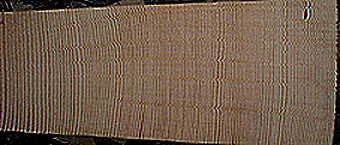 radial tree section with typical "V" design
of annual rings
radial tree section with typical "V" design
of annual rings
 planed spruce plank (side view) with strongly marked
tonewood characteristic
planed spruce plank (side view) with strongly marked
tonewood characteristic
|

A very usefull tool for testing annual growth is the Pressler's
increment borer which is also used to study characteristics and
properties of growing trees.
|
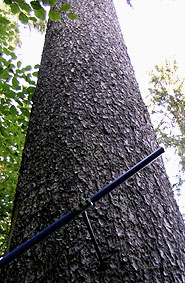 |
 An increment borer is similar to a hollow corkscrew
which will after inserting it into the tree collect a small cylinder
(sample) of wood
An increment borer is similar to a hollow corkscrew
which will after inserting it into the tree collect a small cylinder
(sample) of wood

 A 40 cm long core was extracted from the growing spruce
tree.
A 40 cm long core was extracted from the growing spruce
tree.

Afterwards the extracted sample of wood is placed again in
the same hole made by the borer.
This trees with additional characteristic such as regular
and very narrow annual rings are cut down during early Autumn
and Winter always in waning moon (the period of time after
the full moon) to avoid wood-worms and wood-parasites(fungus).
To obtain the best quality of wood are for instrument making used
only trees which grow on the nord exposed and less inclined slope
as well as on the shady side.
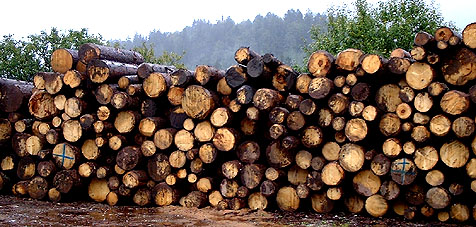
 After beeing cutted down , those tree-truncs are left
to dry on an open space for a while .
After beeing cutted down , those tree-truncs are left
to dry on an open space for a while .
 Finally the logs are quartered by sawing or splitting.
Finally the logs are quartered by sawing or splitting.
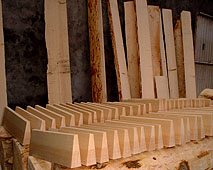 After beeing cutted on size are the planks left a bit
to dry before getting covered with paraffin for crack prevention
.
Afterwards the worked pieces follow a strict natural
seasoning ( oven drying damnage the internal structure
of the wood!) for a while till overtake a humidity of 12%.
After beeing cutted on size are the planks left a bit
to dry before getting covered with paraffin for crack prevention
.
Afterwards the worked pieces follow a strict natural
seasoning ( oven drying damnage the internal structure
of the wood!) for a while till overtake a humidity of 12%.
 Plancs of dried tone-woods are then carefully selected
with the utmost care one by one.
Plancs of dried tone-woods are then carefully selected
with the utmost care one by one.

Splitting knife originally made for shingles. It is a very
usefull tool for hand splitting timber into boards.
The tool is hand-forged.
Approx. weight of the knife 1,300 g.
Approx. blade length 270 mm
price: 65,00 EUR
|
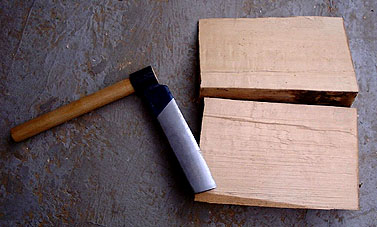
split timber
|
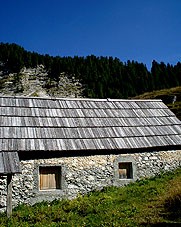
wooden roof with shingles in a mountain village
|
This wood produces a very clear sound and is after
a recent research (1999) considered one of the best and the
quickest acoustic conductor of sound-wave in the world.
 First quality spruce violin plank
First quality spruce violin plank
 haselfichte spruce plank with strongly marked "tonewood"
characteristic
Net price list in EURO for naturally
seasoned spruce planks:
( currency
converter )
haselfichte spruce plank with strongly marked "tonewood"
characteristic
Net price list in EURO for naturally
seasoned spruce planks:
( currency
converter )
|
SELECTION |
VIOLIN |
VIOLA |
CELLO |
VIOLA DA GAMBA |
GUITAR |
LUTE |
|
III q |
11 |
13 |
62 |
50 |
15 |
13 |
|
II q |
18 |
20 |
87 |
75 |
25 |
20 |
|
I q |
29 |
33 |
135 |
120 |
43 |
37 |
| II
q haselfichte* |
26 |
30 |
130 |
115 |
37 |
30 |
| I
q haselfichte* |
33 |
37 |
149 |
136 |
50 |
40 |
|
master * |
50 |
55 |
220 |
180 |
75 |
65 |
* not always available

next page

tonewood(AT)liuteria-antica.com
For any order please submit the
order form
All materials contained
in this web site including images may not be reproduced ,displayed,
published or used by any means without the written permission
of Laboratorio di Liuteria Antica
All rights reserved
1999-2013

















